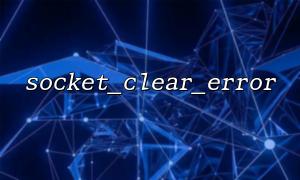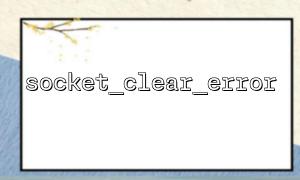In PHP socket programming, debugging errors is an inevitable part of the process. To locate and handle errors more efficiently, the socket_clear_error() function is especially important. This article provides a detailed introduction to the function’s purpose, timing of use, and practical examples during debugging to help developers manage socket error states more accurately.
socket_clear_error() is a function used to clear the last socket error information. It can operate on a specific socket resource or be called without parameters to clear the global error information.
The function prototype is as follows:
socket_clear_error(?Socket $socket = null): void
The parameter $socket is optional. If provided, it clears the error information for that socket; if omitted, it clears the global error state.
When using the PHP Socket API (such as socket_connect(), socket_write(), socket_read(), etc.), errors that occur are stored internally and can be retrieved using socket_last_error(). However, this error state is accumulative. If you don’t actively clear it, it may affect your subsequent logic and judgments.
For example, if a connection attempt fails but you then successfully connect, without calling socket_clear_error(), the error status you retrieve will still reflect the previous failure.
$host = 'm66.net';
$port = 80;
$socket = socket_create(AF_INET, SOCK_STREAM, SOL_TCP);
<p>$attempts = 0;<br>
$connected = false;</p>
<p>while ($attempts < 3 && !$connected) {<br>
socket_clear_error($socket); // Clear previous error state<br>
$connected = @socket_connect($socket, $host, $port);</p>
$errCode = socket_last_error($socket);
echo "Attempt " . ($attempts + 1) . " to connect failed, error: " . socket_strerror($errCode) . "\n";
sleep(1);
}
$attempts++;
}
In the example above, if socket_clear_error() is not called, the error code you retrieve each time might be from the previous attempt, causing a misjudgment.
If your program needs to check whether a socket is in a normal state, this is often done together with socket_last_error(). It’s best to call socket_clear_error() before retrieving the status to avoid interference from previous operations.
socket_clear_error($socket);
$status = socket_get_status($socket);
<p>if ($status['eof']) {<br>
echo "The remote host has closed the connection.\n";<br>
}<br>
When reading or writing in non-blocking mode, many operations may return temporary errors (such as EAGAIN or EWOULDBLOCK), which don’t necessarily indicate fatal errors. In these cases, timely calling socket_clear_error() is key to keeping your logic clean.
socket_set_nonblock($socket);
$result = @socket_read($socket, 2048);
<p>if ($result === false) {<br>
$error = socket_last_error($socket);</p>
// Temporarily not readable, retry later
socket_clear_error($socket);
} else {
echo "Read operation failed: " . socket_strerror($error) . "\n";
}
}
Assuming errors clear automatically: Many beginners believe the error state clears automatically after the next operation, but it does not. You must explicitly call socket_clear_error().
Ignoring clearing for specific sockets: When managing multiple socket resources, remember to pass the specific socket handle to avoid accidentally clearing error states of other sockets.
When debugging socket applications, using socket_clear_error() is not optional but a critical step to accurately understanding the current socket state. It plays an important role in error handling, status checking, and non-blocking communication. Mastering its use can greatly improve your debugging efficiency and program robustness.













